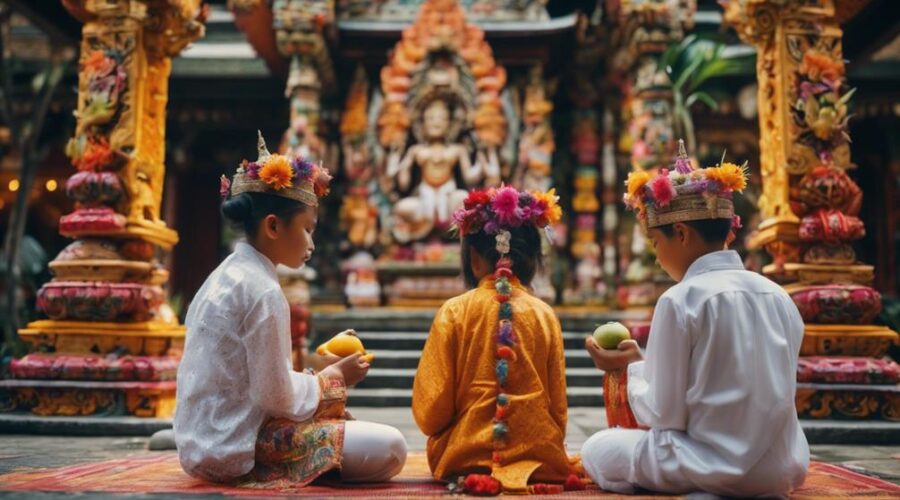Who Do Balinese Worship?
Imagine you're walking through the serene streets of Bali, and you stumble upon intricately designed temples at every corner. It's no secret that spirituality is deeply woven into Balinese culture, but who exactly do the Balinese people worship?
You might be surprised to find out that their religious practices are a complex blend of Hinduism, Buddhism, and animism. But what does this mean for their day-to-day life? How do these beliefs influence their rituals and ceremonies?
There's a fascinating world to explore here, wouldn't you want to know more?
Key Takeaways
- Balinese worship is influenced by Hinduism, venerating deities such as Vishnu, Shiva, Ganesha, and Durga.
- Buddhist teachings and iconography are integrated into Balinese rituals and temple architecture.
- Animistic beliefs in Bali assign spiritual significance to all aspects of nature and inanimate objects.
- Balinese spirituality emphasizes daily rituals, ancestor worship, and the concept of 'Rwa Bhineda', a balance of opposites.
Understanding Balinese Spirituality
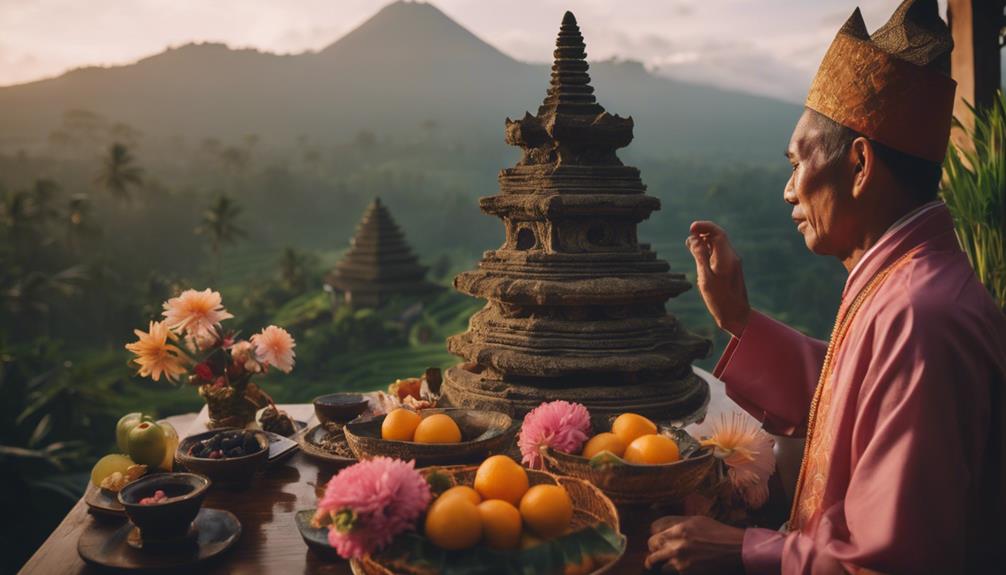
To fully appreciate Balinese worship, it's important to explore into the complexities of Balinese spirituality, a rich tapestry woven from threads of Hinduism, Buddhism, and animist traditions. Balinese Mysticism is a unique amalgamation of these diverse elements, creating a spiritual framework that's both intricate and dynamic.
In the domain of spiritual practices, you'll find an array of rituals and ceremonies that range from the grand to the everyday. Each carries a deep significance, providing a conduit for the Balinese to communicate with the divine and the unseen world. For instance, the daily offerings or 'canang sari' aren't only tokens of gratitude to the gods but also a means to maintain a harmonious relationship with the spiritual world.
Furthermore, the concept of 'Rwa Bhineda' or the balance of opposites plays a pivotal role. It encapsulates the Balinese perception of the universe, where good and evil, chaos and order, are perceived as complementary forces rather than polar opposites. This is an innovative approach to spirituality that challenges conventional binary perceptions.
The Influence of Hinduism
You'll find Hinduism's influence in Balinese worship deeply ingrained, evident in the reverence for Hindu deities, the conduct of rituals and ceremonies, and the architectural elements of Balinese Hindu temples.
The pantheon of gods worshipped in Bali, although uniquely interpreted, is unmistakably Hindu in origin.
The rituals and temples not only reflect the religious beliefs but also the intricate cultural tapestry that weaves together Balinese identity with Hindu traditions.
Hindu Deities in Bali
In the distinctive religious landscape of Bali, a multitude of Hindu deities profoundly shape the spiritual practices and beliefs of the island's inhabitants. The unique blend of Hindu iconography and cultural adaptations is evident in the island's spiritual life.
The deity Vishnu, often illustrated as a protective force, is central to Balinese worship.
Shiva, the destroyer and transformer, holds a complex role, symbolizing both creation and destruction.
Ganesha, the elephant-headed god of wisdom, is a beloved figure across the island.
Durga, a powerful goddess, embodies the feminine energy and is revered for her strength.
Through the lens of these deities, you can perceive the vibrancy of Hinduism in Bali. It's not just about gods and worship, but also about the seamless integration of faith into daily life.
Hindu Rituals and Ceremonies
Often, the influence of Hinduism on Bali is most visibly manifested in the extensive array of rituals and ceremonies that punctuate daily life on the island. These rituals are deeply intertwined with Hindu astrology significance, aligning life events with cosmic rhythms. Purity rituals, for instance, cleanse the spirit, ensuring harmony with divine energies.
| Rituals | Significance |
|---|---|
| Birth Rites | Align with auspicious astrological periods |
| Purity Rituals | Cleanse and harmonize spiritual energies |
| Transformation Rites | Safeguard shift of the soul |
| Temple Ceremonies | Connect community and divine |
These practices reveal a sophisticated, dynamic spiritual system that innovatively fuses indigenous Balinese beliefs with Hindu traditions. Understanding these rituals provides an insightful perspective into the spiritual complexity of Balinese Hinduism. As you explore further, you'll discover the rich tapestry of beliefs that underpin this vibrant island culture.
Balinese Hindu Temples
Ever wondered how Hinduism, a religion that originated in the Indian subcontinent, has influenced the architectural style of Balinese Hindu temples? Let's explore into the profound impact of Hinduism on the Temple Architecture and Sacred Spaces in Bali.
- The majestic Meru towers, inspired by Mount Meru, the Hindu equivalent of Olympus, signify the universe's spiritual center.
- The intricate stone carvings, a distinctive feature of Indian temples, adorn the Balinese temples, showcasing epic Hindu narratives.
- The Mandala spatial arrangement, a Hindu concept, guides the temple layout, creating harmonious, energized spaces.
- Sacred water bodies, reminiscent of the Indian Ghats, form an integral part of these Sacred Spaces.
Hinduism's profound influence has truly transformed Bali's religious landscape, fostering a unique blend of architectural innovation and spiritual tradition.
Balinese Gods and Deities
A myriad of gods and deities permeate Balinese worship, each embodying distinct aspects and domains, shaping the rich tapestry of their spiritual practices. Balinese mythology, packed with a plethora of celestial beings, shapes the island's distinctive religious landscape. The complexity of these divine entities, each with unique iconography and attributes, provides an in-depth understanding of the intricate nature of Balinese worship.
The deities' iconography, important in understanding their roles, isn't merely art, but an insightful gateway into their divine dimensions. For instance, Dewi Sri, the goddess of rice and fertility, is often depicted holding sheaves of rice, symbolizing prosperity. Similarly, the god Barong, represented as a lion, embodies the protective force against malevolent spirits in Balinese mythology.
These elaborate depictions serve as an innovative medium to comprehend the divine, transcending the conventional understanding of religion. The Balinese gods, each laden with symbolic representations, demonstrate the intricate intertwining of mythology, spirituality, and daily life, further enriching the Balinese worship.
In this vast pantheon, each god and deity holds a special place, reflecting the multidimensional nature of Balinese spirituality. It's a world where the divine and human realms coalesce, shaping an intricate and vibrant spiritual tapestry.
Role of Buddhism in Bali
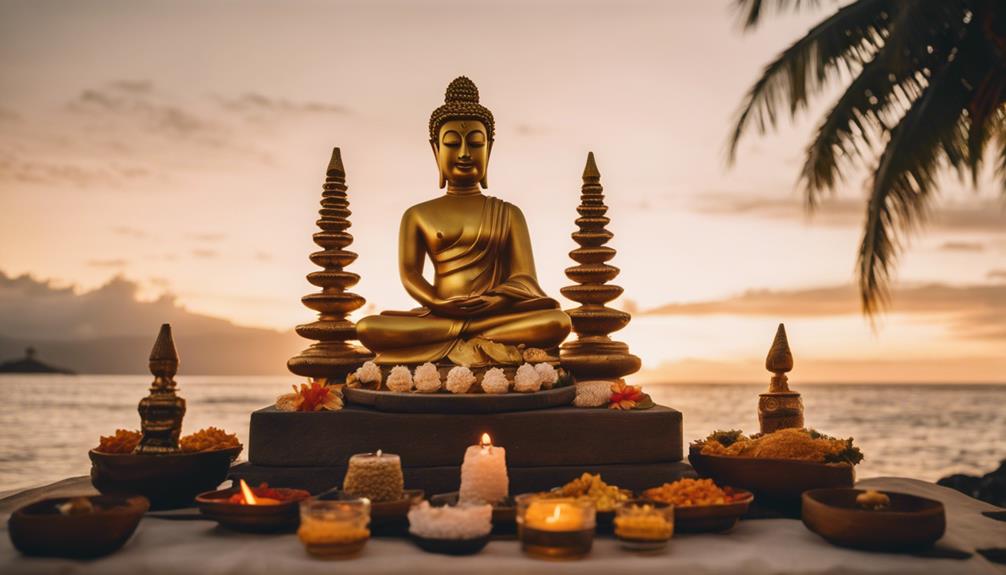
You might find it intriguing to contemplate the profound influence Buddhism has had on Bali, shaping not only its religious practices but also its cultural landscape.
From the intricacies of Balinese Buddhist rituals to the fascinating phenomenon of religious syncretism, Buddhism's imprint is unmistakable.
Let's examine these points closely to gain a better understanding of the role of Buddhism in Bali.
Buddhism's Influence on Bali
Buddhism's imprint on Balinese culture and worship is profound, shaping various facets of spiritual practices and rituals on the island. The Buddhist philosophy, deeply rooted in the Balinese worldview, has contributed to the island's unique blend of spirituality. Monastic traditions have further influenced the Balinese way of life.
To understand this influence:
- Recognize the integration of Buddhist philosophy into Balinese Hinduism, creating a unique religious amalgamation.
- Consider the influence of monastic traditions, particularly in the disciplined behavior and community involvement of Balinese Buddhists.
- Reflect on the architectural influence, where Buddhist motifs are prevalent in many Balinese temples.
- Acknowledge the moral teachings of Buddhism, shaping the ethical conduct of the Balinese.
Indeed, Buddhism's influence is deeply woven into the fabric of Balinese culture.
Balinese Buddhist Rituals
Now that we've explored Buddhism's broad impact on Balinese life, let's turn our focus to its distinct role in shaping local rituals. Balinese rituals often incorporate Buddhist iconography, seamlessly integrating it with local traditions. The use of mandalas, for instance, is a proof of the enduring influence of Buddhism on the island. Such symbols are used not merely as decorative elements but as focal points for meditation, reflecting Zen practices.
The rituals themselves are meticulously planned, with every detail carrying specific significance. This attention to detail is a hallmark of Balinese Buddhism, reflecting the belief that even the smallest action can have profound spiritual implications. The rituals serve as a vivid illustration of the island's unique brand of Buddhism.
Syncretism in Balinese Religion
In examining the syncretism evident in Balinese religion, it becomes clear that Buddhism plays a pivotal role in shaping the island's unique religious landscape. This Spiritual Syncretism is a fusion of beliefs, where:
- Buddhism coexists harmoniously with Hinduism and animism.
- Buddhist concepts are integrated into local ceremonies and rituals.
- Many Balinese incorporate Buddhist statues or symbols in their temples.
- Buddhist teachings influence the ethical and moral codes of Balinese society.
This Affirmation of Bali's religious tolerance and cultural diversity. It's an innovative model of religious integration that can offer lessons to the wider world.
Look deeper and you'll see more than just religious practices; you'll discover a rich tapestry of beliefs that define the spiritual identity of Bali.
Ancestor Worship in Bali
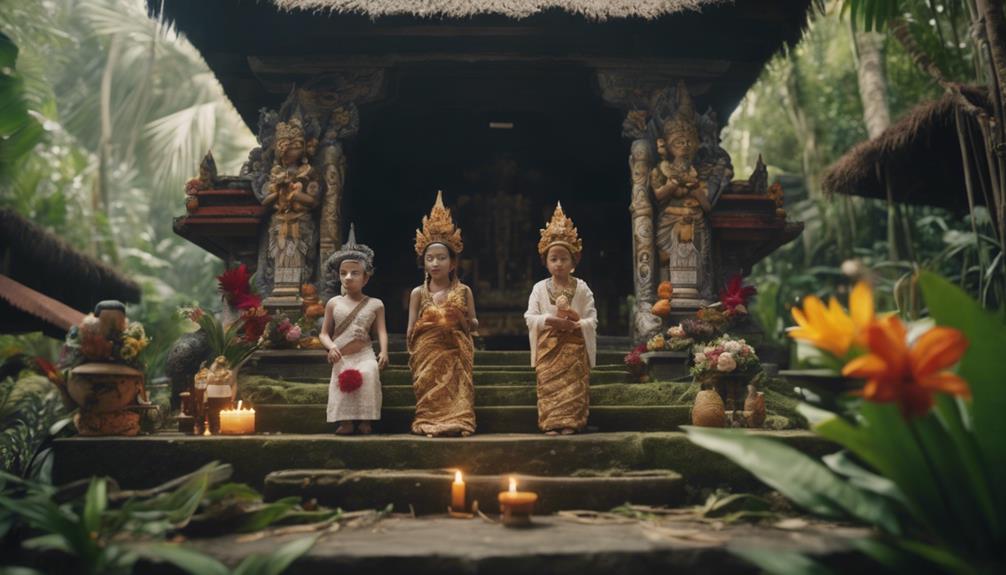
You'll find a deep-rooted tradition of ancestor worship among the Balinese, a practice that seamlessly intertwines with their daily religious rituals and ceremonies. This reverence towards the departed transcends the corporeal, and is embodied in intricate ancestral symbols and death rites that reflect the Balinese spiritual landscape.
Ancestral symbols, or 'sanggah' as the Balinese refer to it, are tangible manifestations of this worship. These miniaturized temple-like structures, often nestled within the family compounds, serve as the focal point for ancestral offerings and prayers. They're meticulously adorned with intricate carvings and vibrant clothes, symbolizing the Balinese's profound connection with their ancestors' spirits.
Balinese death rites, on the other hand, are elaborate and multi-layered, underlining the Balinese belief in the cyclical nature of life and death. The body, viewed as a temporary vessel, is returned to the elements through cremation. This physical dissolution is believed to free the soul for its spiritual journey, facilitating its return to the ancestral domain.
Rituals and Ceremonies
Alongside these deeply ingrained ancestral practices, the rich tapestry of Balinese worship also encompasses a wide array of rituals and ceremonies. These ceremonious events offer an intriguing glimpse into the cultural essence and spiritual fabric of the island's communities. They're not only about appeasing deities or venerating ancestors, but also serve as a vibrant platform for social cohesion and cultural continuity.
You'll observe that each ceremony is characterised by:
- A unique set of ceremonial attire donned by the participants, which are typically vibrant, intricately designed, and steeped in symbolic significance.
- The preparation and sharing of festive foods as a community, which isn't only a gastronomic delight but also a ritualistic expression of unity and gratitude.
- The creation of elaborate offerings and ornate shrines, lending an aesthetic dimension to the spiritual proceedings.
- The performance of traditional music and dance, which breathes life into these ancient rituals and captures the dynamic spirit of Balinese culture.
Each element of these ceremonies, from the ceremonial attire to the festive foods, carries a deeper significance that embodies the Balinese philosophy of harmony, gratitude, and community solidarity.
Animism in Balinese Culture
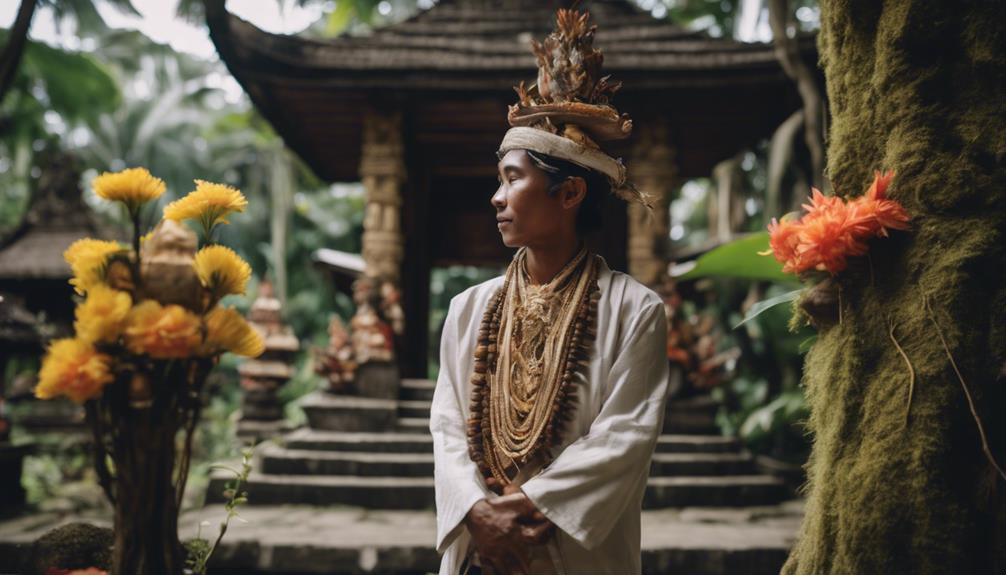
Delving deeper into the spiritual fabric of Balinese culture, it's important to understand the role of animism, a belief system that imbues all aspects of nature and inanimate objects with spiritual significance. Animistic symbols are prevalent, reflecting a profound reverence for nature.
Animism holds that every object, no matter how mundane it may seem, has a spiritual essence or life force. This belief deeply influences the daily lives, rituals, and art forms of the Balinese people. The intricate carvings and designs often seen in Balinese architecture and traditional crafts are more than just aesthetic expressions—they are manifestations of animistic symbols, each with its own spiritual meaning.
To further illustrate the animistic elements in Balinese culture, consider this table:
| Object | Spiritual Essence | Significance |
|---|---|---|
| Trees | Dewa (Deities) | Nature Reverence |
| Stones | Hyang (Ancestral Spirits) | Ancestral Worship |
| Water | Taksu (Charisma) | Purification |
| Rice | Dewi Sri (Goddess of Rice) | Fertility and Prosperity |
This table represents a small fraction of the myriad objects the Balinese imbue with spiritual significance. It serves as a attestation to the profound intertwining of the physical and spiritual realms in Balinese culture.
Impact of Spirituality on Everyday Life
Drawing from the spiritual essence Balinese people attribute to different objects, it's clear that their spirituality profoundly shapes their daily lives. Their spiritual well being is a cornerstone, anchoring every action and thought.
- Balinese meditation, for instance, isn't just a practice, but a lifestyle. It's a way to cleanse the mind, promoting tranquility and peace.
- The spiritual connection to nature is also palpable, with offerings made to spirits believed to reside in trees, rivers, and stones.
- Daily routines, from cooking to crafting, are performed with a mindful presence, seeing divine significance in the mundane.
- Community activities, such as festivals and ceremonies, are also imbued with spiritual meaning, fostering a sense of solidarity and collective spirituality.
This deep-seated spirituality, in turn, impacts the Balinese perspective on life, death, and everything between. It's a paradigm that champions the pursuit of balance between the physical and spiritual universes, and this balance is mirrored in their daily activities. Spirituality isn't just a part of life for the Balinese—it is life. And this profound connection to the spiritual world has potential to inspire innovative approaches to well being, mindfulness, and community cohesion.

